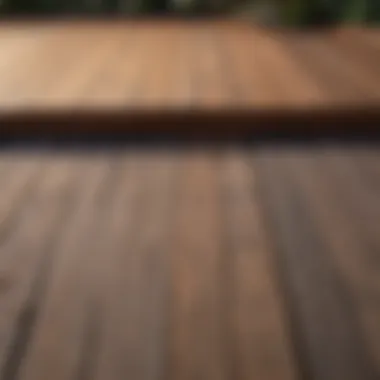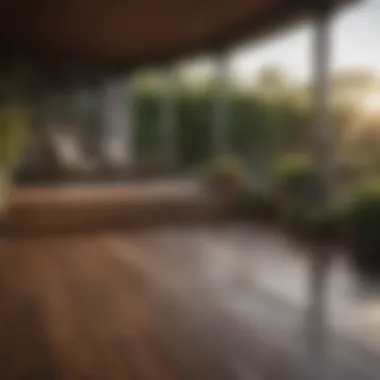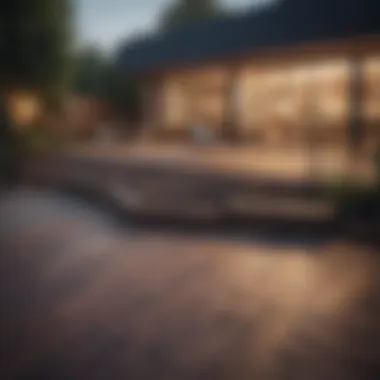Cost Analysis of a 10x10 Deck: Key Insights


Intro
Constructing a deck can significantly enhance the functionality and aesthetic appeal of your outdoor space. A 10x10 deck is a popular choice for many homeowners due to its manageable size and versatility. Before embarking on this project, it is essential to understand the financial aspects involved in building such a structure. This analysis will explore the costs related to materials, labor, and maintenance required for a 10x10 deck. By unpacking these details, you can better prepare yourself for budget considerations and make informed decisions.
Ultimately, the goal is to furnish you with the insights needed to approach this home improvement project with clarity and confidence. With a well-informed perspective, you can maximize your investment in your deck, ensuring it remains a valuable part of your property.
Design Inspirations
When considering a deck, aesthetics play a crucial role in its appeal. The design elements you choose can significantly impact not only the overall look of the deck but also its functionality and integration with your existing home layout.
Trending Styles
Currently, many homeowners gravitate toward minimalist and contemporary designs. Features such as clean lines and simple structures often dominate the scene. However, rustic and traditional styles remain time-honored choices, especially for those with more conventional tastes. Here are some popular styles:
- Modern Minimalist: Focused on simplicity and elegance. Typically features straight lines and muted colors.
- Rustic Charm: Generally employs natural wood finishes, emphasizing texture and warmth.
- Contemporary Fusion: Blends modern and traditional elements, offering versatility in design.
Color Palettes
The choice of colors can set the mood of your outdoor space. Neutral tones like gray and beige can provide a sophisticated backdrop, while brighter hues can inject energy into your environment. Consider these palettes:
- Natural Wood Shades: Often left untreated or with a clear sealant to showcase the wood's richness.
- Grays and Whites: Ideal for modern aesthetics; these colors work well with current architectural trends.
- Bold Accents: Colors like deep reds or blues can be introduced through furniture or decorative pieces, creating focal points on the deck.
The right design will not only enhance your enjoyment but may also influence future property value.
Maintenance and Upkeep
The longevity of your 10x10 deck largely depends on the upkeep and maintenance you perform. Ongoing care will not only preserve its aesthetic but also the structural integrity of the deck.
Seasonal Maintenance Checklist
To keep your deck in prime condition throughout the seasons, consider this checklist:
- Spring: Inspect for any winter damage and clean debris. Check for mold or mildew and treat if necessary.
- Summer: Apply protective sealants if not done in the previous year. Ensure furniture and accessories are in good condition.
- Fall: Clear leaves and prepare the deck for winter. Inspect for any wear and tear.
- Winter: Keep the deck clear of snow and ice to prevent damage.
Cleaning and Organization Tips
Regular cleaning can prolong the life of your deck materials. Utilize these tips for maintaining a tidy and clean outdoor space:
- Use a mixture of soap and water for routine cleaning.
- Invest in a pressure washer for deeper cleaning tasks.
- Store furniture and decor properly during off-seasons to minimize wear.
This consistent attention to detail in maintenance not only preserves the deck but enhances your experience as a homeowner.
"Investing in proper deck maintenance may seem tedious, but the payoff in enjoyment and property value is substantial."
As you navigate through the costs and factors associated with building a deck, these insights will serve as a guiding framework. From choosing the right materials to maintaining your deck throughout the seasons, each consideration contributes to a well-rounded perspective of the total cost spectrum.
Understanding Deck Costs
When considering the construction of a 10x10 deck, understanding the costs involved is paramount. Decking projects can often appear straightforward. However, various factors—ranging from materials to labor—can significantly impact total expenses. This section will elucidate key elements that influence overall costs and provide a foundation for effective budgeting.
Preamble to Decking Expenses
Decking expenses encompass more than just the initial materials used. Homeowners should approach this project with a holistic perspective. Every cost associated with building a deck contributes to the larger financial picture. These expenses can be broadly categorized into materials, labor, permits, and ongoing maintenance.
A basic understanding of these factors helps in identifying where adjustments can be made for better budgeting. Knowing whether to invest in higher-quality materials now versus maintaining long-term maintenance will influence costs significantly.


In terms of material selection, options vary widely. For instance, pressure-treated wood is typically more affordable upfront, yet it may lead to higher long-term upkeep costs. Conversely, composite materials may require a higher initial investment, but they often come with reduced maintenance needs. This analysis of costs is essential for making informed decisions based on individual circumstances.
Importance of Size
Size plays a critical role in the financial planning of deck construction. A 10x10 deck is relatively small but still presents unique challenges and considerations. While a smaller deck may suggest lower material costs, it is still necessary to account for the fixed costs of labor and permits which do not scale down proportionately with size.
Moreover, deck size influences functionality. A 10x10 deck is generally suitable for compact areas, but it may not accommodate as many features or accessories as larger options. Therefore, homeowners should consider the intended use of the deck and its capacity for hosting gatherings or other activities.
Spending more on durable materials or thoughtful design elements—even on a smaller scale—can yield a higher satisfaction and prolonged use. Hence, understanding the size in relation to costs helps in making strategic decisions that align with both budget and lifestyle needs.
Materials Selection
Selecting the right materials for a deck is crucial for determining both initial expenditure and long-term performance. The choice of materials significantly impacts the deck's durability, maintenance needs, and aesthetic appeal. Thus, understanding the various aspects of decking materials is essential for homeowners looking to make informed decisions.
Types of Decking Materials
When it comes to decking materials, there are several options available. Each material presents distinct features, advantages, and disadvantages.
- Pressure-Treated Lumber: One of the most common materials, pressure-treated wood is chemically treated to resist moisture, rot, and insect damage. It tends to be cost-effective but may require regular maintenance, such as staining or sealing, to enhance its lifespan.
- Composite Decking: Made from a blend of wood fibers and recycled plastic, composite decking is designed to mimic the look of natural wood while offering enhanced durability. This material is often touted for low maintenance, as it doesn’t require sanding or painting.
- Cedar and Redwood: These types of wood have natural resistance to decay and insects due to their high tannin content. They offer aesthetic appeal but can be pricier than pressure-treated options and require regular maintenance to prevent fading and weather damage.
- PVC Decking: Unlike wood, PVC decking is 100% plastic, making it resistant to moisture, stains, and insect damage. It maintains its color over time and requires minimal maintenance. However, it can be expensive compared to other materials.
Cost Comparison of Materials
The financial aspect of decking materials varies greatly. Homeowners must weigh the upfront costs against long-term maintenance. Consider the following examples of material costs:
- Pressure-Treated Lumber: Typically priced at $2 to $5 per square foot, this is often the most budget-friendly option initially.
- Composite Decking: Prices can range from $5 to $13 per square foot. Although higher on the initial investment, lower maintenance may offset costs down the line.
- Cedar and Redwood: Expect to pay between $3 to $7 per square foot, depending on the quality and sourcing.
- PVC Decking: This material tends to be at the higher end, with costs from $7 to $15 per square foot.
By comparing these costs, homeowners gain insight into which material aligns with their budget over time.
Composite vs. Wood Decking
Deciding between composite and wood decking involves examining performance, aesthetics, and price. Composite decking is designed to withstand the elements with little upkeep, making it ideal for those prioritizing longevity. However, it lacks the classic look and feel of natural wood, which appeals to many.
Benefits of Composite Decking:
- Minimal maintenance is required; just an occasional wash is enough.
- No risk of splintering, which increases safety, especially for families with children.
Drawbacks of Composite Decking:
- Higher upfront costs can be a barrier.
- Some may find it less visually appealing compared to natural wood.
In contrast, wood decking provides an organic appearance and can elevate the charm of outdoor spaces but requires commitment in terms of maintenance and periodic treatments.
- Benefits of Wood Decking:
- Drawbacks of Wood Decking:
- Classic beauty and warmth that can enhance any outdoor setting.
- Easier to customize, as it can be sanded and refinished.
- Extensive maintenance is necessary, which can add to costs over time.
- Vulnerable to rot and insect damage, potentially leading to earlier replacement.
In the long run, choosing between composite and wood is not merely a financial decision, but also reflects personal preference regarding maintenance commitment and aesthetic values.
Understanding these different aspects of materials selection is vital for making a well-informed decision regarding deck construction. This knowledge lays the groundwork for a successful and satisfying deck-building experience.
Labor Costs
Labor costs play a crucial role in the overall budget for constructing a 10x10 deck. Understanding these expenses is vital for homeowners planning their projects. Labor can often account for a significant portion of the total cost, and decisions made in this area can greatly influence the project's feasibility and final outcome. This section will delve into the costs related to hiring professionals versus tackling the project as a DIY endeavor, explore average labor rates, and examine the typical timeframe required for construction.


Hiring Professionals vs. DIY
Choosing between hiring a professional contractor and taking a do-it-yourself approach is a key decision when building a deck. Hiring a professional can be more expensive, yet they often bring expertise and experience that ensures high-quality work. They can navigate complex aspects like local building codes and safety regulations more efficiently than most homeowners. This can reduce the likelihood of costly mistakes down the line.
On the other hand, DIY projects provide the potential for significant savings. Homeowners can save on labor costs by doing the work themselves. However, this approach requires a good understanding of carpentry and deck-building techniques. Additionally, the learning curve can lead to longer completion times and possible errors, which might result in unexpected expenses. Ultimately, whether to hire a professional or go DIY depends on one’s skills, budget, and confidence in completing the project.
Estimated Labor Rates
Labor rates for deck construction can vary widely based on factors such as geographical location, contractor experience, and project complexity. On average, hiring a professional contractor can cost between $15 to $50 per hour. In some areas, rates might exceed $100 per hour, especially for highly skilled labor. Additionally, some contractors charge a flat fee for projects, which may range from $1,500 to $3,000 for a simple 10x10 deck build. Factors influencing these rates include:
- Location: Urban areas typically have higher labor costs than rural regions.
- Experience Level: Seasoned professionals may charge more but can deliver a higher-quality outcome.
- Project Specifications: Complex designs and requirements will increase labor rates.
Timeframe for Construction
The timeframe for constructing a 10x10 deck can also impact labor costs. A professional might complete the project in a few days, depending on variables such as weather conditions and workforce availability. DIY projects, however, tend to take longer due to inexperience or other commitments, potentially spanning several weekends or even weeks.
"Estimating construction time accurately can help avoid frustration and keep the project on schedule."
Factors that affect the timeframe include:
- Preparation Work: Site preparation and obtaining permits can add days to the timeline.
- Material Availability: Delays in material delivery can hinder progress.
- Weather Conditions: Rain or extreme heat can slow down the construction process.
Permits and Regulations
Constructing a deck involves navigating a series of permits and regulations that vary depending on local jurisdictions. Understanding these requirements is crucial for homeowners and builders. Ignoring regulations can lead to fines or orders to dismantle the deck, making knowledge of this area very important.
Understanding Local Codes
Local codes dictate how a deck should be built, emphasizing safety and structural integrity. These codes often include specifications on materials, foundation depth, and spacing of support beams. Homeowners must ensure their project complies with these regulations.
Before starting any construction, it is essential to:
- Research local building codes. Each city or county may have different regulations.
- Check for zoning laws. These might restrict the size or height of a deck.
- Consult with a building official who can provide insights related to permits and inspections needed.
By adhering to these codes, you ensure your deck is both safe and legally compliant. This diligence can save time and money, preventing future issues from arising.
Permitting Costs
Obtaining the necessary permits incurs certain costs, which vary widely by location and type of deck. Here are some aspects to consider regarding permitting costs:
- Application Fees: These are often required to submit your plan for review. The fees can range from a nominal amount to several hundred dollars, depending on your location.
- Inspection Fees: Most municipalities will require inspections during various stages of construction. Each inspection might carry a fee.
- Additional Costs: This could include revision fees if your initial plans do not comply with local building codes.
Homeowners should factor in these costs when budgeting for their deck.
"Ignoring permits can lead to financial penalties. It's often cheaper in the long run to invest in understanding and securing your permits."
Additional Considerations
When planning a deck, one must look beyond the basic structure, materials, and labor costs. Additional considerations can greatly influence the final expense and usage of the deck. Homeowners should be mindful of various elements that not only enhance the deck’s functionality but also elevate its aesthetic appeal. The choices made here can lead to unexpected costs or savings down the road.
Deck Accessories and Features
Deck accessories play a pivotal role in how the space will serve its purpose. Lighting options can transform a simple deck into an inviting evening space. LED lights come with varying price ranges and installation complexity. For those who entertain often, built-in speakers or outdoor heaters may be advisable, adding to costs but enhancing enjoyment. Additionally, features such as railings or stairs need careful selection as they contribute not just to safety but also to design.
Popular accessories include:


- Outdoor furniture to create a cozy atmosphere
- Planters for greenery, which can also complement the aesthetic
- Fire pits for warmth and ambiance
Each accessory adds both functionality and charm but should be chosen with a long-term mindset to avoid frequent replacements or renovations.
Maintenance and Upkeep Costs
Decks require ongoing maintenance, which can be a hidden cost for many homeowners. Proper upkeep not only ensures safety but also preserves the investment over time. The material selected will dictate the extent and type of maintenance required. For example, wooden decks need regular sealing, while composite materials offer lower maintenance but might still require occasional cleaning.
It is essential to allocate a budget for:
- Seasonal cleaning: Removing debris and ensuring drainage
- Restoration: Sanding, staining, or sealing wooden decks to prevent decay
- Repairs: Addressing wear and tear, which can be predictive if maintenance is lacking
"Maintaining your deck properly is what prevents larger, costlier problems down the line."
Insurance and Warranties
Understanding the insurance implications related to your deck is crucial. Not all standard home insurance policies automatically cover outdoor structures. Homeowners should check their policy specifics and consider supplemental coverage if necessary. Accidents can lead to liability claims, especially if guests are using the deck.
Moreover, warranties provided by manufacturers of decking materials should not be overlooked. These can offer peace of mind and cover defects or wear under certain conditions. Homeowners should read the fine print, as many warranties have specific stipulations about maintenance, which must be adhered to for the coverage to remain valid. Understanding these details can help avoid unexpected out-of-pocket expenses.
Estimating Total Deck Costs
Estimating the total costs of building a 10x10 deck is foundational in ensuring a successful project. Homeowners often overlook this crucial step, which can lead to budget overruns and future complications. Understanding the estimated costs can help set realistic expectations and inform better decision-making throughout the decking process. It integrates all financial aspects, from materials to labor to maintenance, providing a comprehensive overview that is vital for both planning and executing the construction effectively.
Calculating Overall Expenses
Calculating the overall expenses for your 10x10 deck requires precise attention to detail. Start by tallying the costs of your selected materials. For instance, hardwood decking might cost more but offer durability, while composite materials could provide a more cost-effective and low-maintenance option.
Labor costs also require careful calculation. Hiring a contractor typically comes with rates that can vary significantly based on experience and local demand. It’s important to acquire at least three quotes to ensure you're getting a fair price. Additionally, if you decide to take on some of the work yourself, such as demolition or preparation, you can lower these costs.
In addition to materials and labor, don’t forget to factor in permits and possible fees associated with regulations. Depending on your location, some may be significant. Finally, always estimate some additional percentage (about 10-15%) on top of your calculated expenses. This contingency fund can prevent financial stress if unexpected costs arise.
Cost-Saving Strategies
When it comes to constructing a 10x10 deck, many cost-saving strategies can be employed:
- Research and Compare Prices: Before making any purchases, compare local and online prices for materials. Some suppliers might offer discounts or better deals.
- Choose Affordable Materials: While high-end materials are appealing, opting for more economical options can save a considerable amount. Pressure-treated wood might suffice for many homeowners.
- Consider Off-Season Work: Scheduling your project during the off-season can lead to lower labor costs and availability of materials at discount prices.
- DIY Where Possible: Taking on tasks yourself, like the construction of railings or installing lighting, can significantly cut labor costs.
- Utilize Reclaimed Materials: Reclaimed wood can be both cost-effective and environmentally friendly. There are many sources for salvaged materials that can add character to your deck.
Implementing these strategies can not only maximize your budget but also enhance the overall process of building your deck. Always be proactive in gathering information and weighing options.
"Budgeting for a deck should never be an afterthought. Planning ahead can save you from obstacles down the road."
Any homeowner planning a deck project must arm themselves with knowledge about estimated total costs. This not only supports current decisions but also lays the groundwork for future renovations or upgrades.
Epilogue and Recommendations
Analyzing the costs associated with building a 10x10 deck is crucial for anyone contemplating such a project. This section serves to consolidate key insights and recommendations that have emerged throughout the article.
The process of erecting a deck involves various financial factors—material selection, labor costs, and additional expenses. Each of these elements can significantly influence the total budget required. Homeowners should prioritize understanding how these factors play into their specific projects.
Importance of Comprehensive Planning
Taking the time to plan and estimate costs can prevent overspending and potential disappointments. A well-structured budget allows for informed choices about materials and labor. Avoiding surprises later is essential; hence, the significance of researching local labor rates and material prices cannot be overstated.
Key Recommendations
- Research Material Options: Investigate the various decking materials available, such as wood, composite, and PVC. Each has different price points, durability, and maintenance needs.
- Labor Considerations: Weigh the benefits of hiring professionals against doing it yourself. Professionals may save time, but DIY can lower costs, provided you have the right skill set.
- Understand Permits Required: Familiarizing yourself with local building codes and required permits can save you from legal and financial headaches later on.
- Budget for Accessories: Don’t forget to include accessories and features, like railings, lighting, and seating. These can enhance functionality but also add to the overall cost.
Taking these recommendations into account will enhance the probability of a successful deck-building experience. Attentiveness to details will help ensure that all factors are considered, leading to a smooth and satisfying project.
Final Thoughts
Building a deck can be a fulfilling project both for enjoyment and for increasing property value. A thoughtful approach involving comprehensive cost analysis is essential. Armed with a well-laid plan, property owners can make choices that align with their budgets and preferences, ensuring the final product meets both aesthetic and functional needs.







